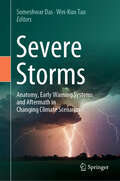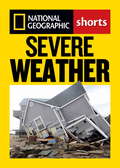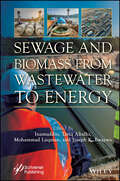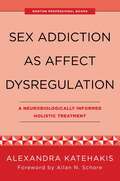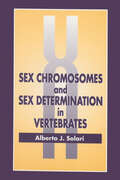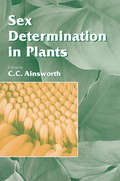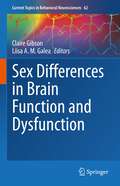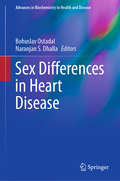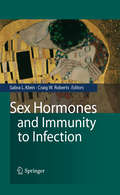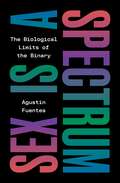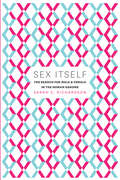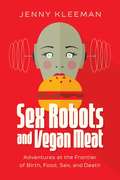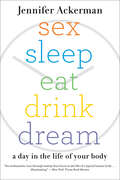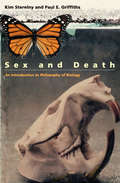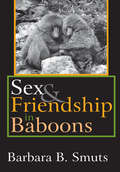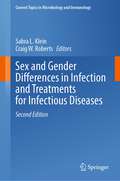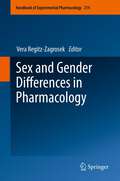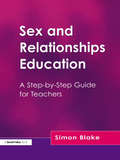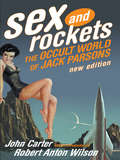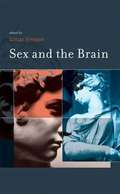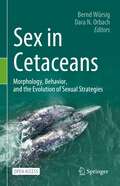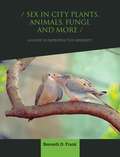- Table View
- List View
Severe Storms: Anatomy, Early Warning Systems and Aftermath in Changing Climate Scenarios
by Wei-Kuo Tao Someshwar DasThe book provides information on the observational aspects of the severe storms through satellite, radar, aircraft, and ground based network of stations and these issues are discussed in the first part of the book consisting of 8 chapters. The numerical modelling and data assimilation techniques are discussed in the second part of the book aimed at development of Early Warning Systems (12 chapters) and finally the outlook of the severe storms in a changing climate scenario, their socio-economic impacts and policies for disaster mitigation are discussed in the third part of the book consisting of 6 chapters. This book is of great interest to atmospheric scientists and other researchers, practitioners, policy and decision makers, international institutions, governmental and non-governmental organizations, educators, as well as students.
Severe Weather
by Kathy Furgang Brett KellyWhat causes major storms and how can you stay safe when one blows in? Why is it important to have an emergency plan? Read this book to find out how you can predict severe weather conditions and protect yourself against them. (Set of 10)
Severe Weather
by National GeographicWeather-related tragedies have fascinated humans throughout time. For those who loved The Perfect Storm andKrakatoa, the millions who log onto daily weather forecasting sites and check weather apps, and people who can't get enough front-page headlines of global natural disasters. Earthquakes, hurricanes, tornados, floods, forest fires, blizzards, and thunderstorms: National Geographic explores the deadliest of these disasters throughout history and arms you with ways to protect yourself from chaos and destruction. From the 1906 earthquake that flattened San Francisco and the morbid 1889 flash flood that wiped out the entire town of Johnstown, Pennsylvania, to the Superstorm of 1993 that blanketed Florida in snow and the more recent East Coast and Gulf Coast ravages of hurricanes Katrina and Sandy, the destructive force and human tragedy both fascinates and horrifies. In addition to these gripping stories, NGS provides practical tips for surviving at home and weathering the lethal strength of these events if caught outside.
Sewage and Biomass from Wastewater to Energy: Possibilities and Technology
by Inamuddin Mohammad Luqman Tariq Altalhi Joseph KapukuWritten and edited by a team of industry experts, this exciting new volume covers clean energy production from sewage and biomass while achieving a zero-waste strategy. Wastewater treatment plants are critical in protecting both the environment’s resources and human health. A wastewater treatment plant’s technological system focuses not only on the effectiveness of the treatment but on the costs and energy consumption of the entire system. Municipal wastewater treatment produces a significant amount of sewage sludge all over the world. The majority of this sludge’s dry matter content is made up of organic compounds which are not toxic, and they consist of both primary and secondary (microbiological) sludge. There is also a substantial quantity of inorganic substances in the sludge, along with a small quantity of toxic matter. Also, various raw sewage treatment options can include energy production (heat, electricity, or biofuel) to reduce dependence on external energy supply during treatment. The most important options used for energy production from sewage and biomass can use the following approaches: anaerobic digestion, co-digestion, incineration with energy recovery, co-incineration, pyrolysis, gasification, supercritical (wet) oxidation, and hydrolysis. Generally, these processes or methods are cost-effective, but they can still have some setbacks related to the nature of the methods or the raw material used for conversion. There are also operating conditions to comply with to get a successful outcome. This book combines information from many disciplines related to wastewater treatment technologies to show how the circular economy approach can be used to achieve zero waste and produce energy that can be useful for plants and communities. This approach focuses on clean technologies for green energy resources such as biohydrogen, biofuels, and biogas from biomass and sewage sludge for zero waste production. This is aimed to also integrate the issue of energy demand and the one of energy production.
Sex Addiction as Affect Dysregulation: A Neurobiologically Informed Holistic Treatment (Norton Series On Interpersonal Neurobiology Ser. #0)
by Alexandra KatehakisExamining the neurobiological underpinnings of sex addiction. Neuroaffective science—studying the integrated development of the body, brain, and mind—has revealed mechanisms linking psychological and biological factors of mental disorders, including addiction. Indeed, its paradigm-shifting theoretical umbrella demonstrated that substance and behavioral dependencies share identical neurobiological workings, and thus that problematic repetitive behaviors are genuine addictions—a state increasingly understood as a chronic brain disorder. Clinical experience strongly suggests that sex addiction (SA) treatment informed by affective neuroscience—the specialty of Alexandra Katehakis—proves profoundly transformative. Katehakis's relational protocol, presented here, blends neurobiology with psychology to accomplish full recovery. Her Psychobiological Approach to Sex Addiction Treatment (PASAT) joins therapist and patient through a relationally-based psychotherapy—a holistic, dyadic dance that calls on the body, brain, and mind of both. Written with clarity and compassion, this book integrates cutting-edge research, case studies, verbatim session records, and patient writings and art. Katehakis explicates neurophysiological, psychological, and cultural forces priming and maintaining SA, then details how her innovative treatment restores patients' interpersonal, sexual, and spiritual relationality.
Sex Chromosome Abnormalities And Human Behavior: Psychological Studies
by Daniel B Berch Bruce G BenderThis volume is based on a symposium, "Cognitive and Psychosocial Dysfunctions Associated with Sex Chromosome Abnormalities," presented at the 1986 Annual Meeting of the American Association for the Advancement of Science. It contains reports from individual research groups and a psychological study.
Sex Chromosomes and Sex Determination in Vertebrates
by Alberto J. SolariThe cloning of the SRY gene and the attainment of XX mice transgenic for the Sry gene opened a new era in research on sex determination. This book surveys current knowledge of sex chromosomes and sex determination in all vertebrate classes, relying on the restriction of genetic recombination in sex chromosomes as the unifying concept of this subject. The book's interdisciplinary approach integrates contributions from the fields of cytogenetics, molecular biology, developmental biology, and evolutionary genetics. A detailed treatment of the meiotic behavior of sex chromosomes is featured, and the entire text is supplemented by numerous schemes, drawings, and electron micrographs.The book will be valuable to general cytogeneticists, vertebrate zoologists, and veterinarian and medical practitioners interested in the foundations of sex determination and the current knowledge of sex chromosomes. It will also interest students in advanced undergraduate and graduate courses in these areas.
Sex Determination in Plants (Society for Experimental Biology)
by C. C. AinsworthIndispensable for all plant biologists, this is a fascinating and thorough examination of those factors which affect the sex determination of plant species, describing all of the main classes of plant with unisexual flowers hermaphrodite, monoecious and
Sex Differences in Brain Function and Dysfunction (Current Topics in Behavioral Neurosciences #62)
by Claire Gibson Liisa A. M. GaleaDoes sex matter when it comes to brain function? This volume attempts to answer this very important question which is of relevance to the disciplines of psychology, neuroscience, psychiatry and neurology. Understanding how brain function and resultant behaviors may differ between the sexes impacts upon our knowledge of the pathology and development of treatments for various neurological and psychiatric disorders, particularly those that show significant sex differences in either prevalence and/or manifestation of symptoms. This volume covers three main themes of research into sex differences in basic neurobiology, psychology, preclinical research and clinical research. It begins by exploring our understanding of sex and gender in relation to both animal and human behaviors and discusses the relevance, and importance, of considering sex and gender when conducting research into brain function and behaviors. The second theme focuses on how sex and gender influence mental health and considers the impact of our immune system and the changes that occur with ageing. Finally, the third aspect focuses on examples of neurological disorder which show sex differences in terms of their aetiology and/or symptomology and considers the relevance in the development of treatment for these disorders including dementia, stroke and multiple sclerosis. This volume is of considerable interest to mental health and neurology professionals, including psychiatrists, neurologists, nurses, allied health clinicians and pharmacists. It is also helpful and important for preclinical researchers working in neuroscience, psychopharmacology and reproductive endocrinology.
Sex Differences in Heart Disease (Advances in Biochemistry in Health and Disease #21)
by Bohuslav Ostadal Naranjan S. DhallaCardiovascular diseases are the leading cause of mortality in men and women. Unfortunately, women have traditionally been excluded from clinical trials, and female animals have been used less or sex was not reported in basic research studies. Until recently, consideration of both sexes was not required in clinical and preclinical studies focusing on cardiovascular diseases. However, the number of clinical and experimental papers dealing with sex differences and heart disease significantly increases during the last years. This trend is obviously the result of at least two facts: the number of examples of different behavior of the male and female heart under physiological and pathological conditions is steadily increasing and there were controversial reports on the beneficial and adverse effect of hormonal replacement therapy. Detailed molecular and cellular mechanisms of these differences are still unknown but one is clear already today: sex differences are so important that they should be considered by the selection of optimum diagnostic and therapeutic procedures in clinical practice.The book presents 16 manuscripts on sex differences of heart disease, as developed by several investigators; the volume is organized in four parts. Part I, dealing with sex differences in cardiac ischemic injury, includes 5 chapters on experimental aspects of cardiac ischemia/reperfusion injury, the role of testosterone, and clinical aspects of ischemic heart disease. Part II is devoted to sex differences in heart failure and includes four chapters. Discussion in this part of the book is centered around the sex differences in heart failure due to volume overload. Part III of this volume includes four papers on risk factors of cardiovascular diseases, namely hypertension and obesity, and, finally, three chapters in part IV deal with sex differences of cardiac mitochondria under different pathological conditions. We believe this book will be very useful for cardiovascular scientists, graduate students, postdoctoral fellows and other health professionals.
Sex Hormones and Immunity to Infection
by Craig Roberts Sabra L. KleinWhy sex matters Among human and nonhuman animals, the prevalence and intensity of infection typically is higher in males than females and may reflect differences in exposure as well as susceptibility to pathogens. Elevated immunity among females is a double-edged sword in which it is beneficial against infectious diseases but is detrimental in terms of increased development of autoimmune diseases. The present book critically reviews the evolutionary origin and the functional mechanisms responsible for sexual dimorphism in response to infection. It emphasizes the value of examining responses in both males and females to improve our understanding about host-pathogen interactions in both sexes. The contributors are experts in their specific disciplines which range from microbiology and immunology to genetics, pathology, and evolutionary biology. The book aims at bringing insight to the treatment and management of infectious diseases; it delineates areas where knowledge is lacking and highlights future avenues of research.
Sex Is a Spectrum: The Biological Limits of the Binary
by Agustín FuentesWhy human biology is far more expansive than the simple categories of female and maleBeing human entails an astonishingly complex interplay of biology and culture, and while there are important differences between women and men, there is a lot more variation and overlap than we may realize. Sex Is a Spectrum offers a bold new paradigm for understanding the biology of sex, drawing on the latest science to explain why the binary view of the sexes is fundamentally flawed—and why having XX or XY chromosomes isn&’t as conclusive as some would have us believe.In this lively and provocative book, leading biological anthropologist Agustín Fuentes begins by tracing the origin and evolution of sex, describing the many ways in the animal kingdom of being female, male, or both. Turning to humans, he presents compelling evidence from the fossil and archaeological record that attests to the diversity of our ancestors&’ sexual bonds, gender roles, and family and community structures, and shows how the same holds true in the lived experiences of people today. Fuentes tackles hot-button debates around sports and medicine, explaining why we can acknowledge that females and males are not the same while also embracing a biocultural reality where none of us fits neatly into only one of two categories.Bringing clarity and reason to a contentious issue, Sex Is a Spectrum shares a scientist&’s perspective on why a binary view of sex and gender is not only misguided but harmful, and why there are multitudes of ways of being human.
Sex Itself: The Search for Male and Female in the Human Genome
by Sarah S. RichardsonHuman genomes are 99. 9 percent identicalOCowith one prominent exception. Instead of a matching pair of X chromosomes, men carry a single X, coupled with a tiny chromosome called the Y. aTracking the emergence of a new and distinctive way of thinking about sex represented by the unalterable, simple, and visually compelling binary of the X and Y chromosomes, "Sex Itself" examines the interaction between cultural gender norms and genetic theories of sex from the beginning of the twentieth century to the present, postgenomic age. aaaaaaaaaaaUsing methods from history, philosophy, and gender studies of science, Sarah S. Richardson uncovers how gender has helped to shape the research practices, questions asked, theories and models, and descriptive language used in sex chromosome research. From the earliest theories of chromosomal sex determination, to the mid-century hypothesis of the aggressive XYY supermale, to the debate about Y chromosome degeneration, to the recent claim that male and female genomes are more different than those of humans and chimpanzees, Richardson shows how cultural gender conceptions influence the genetic science of sex. aaaaaaaaaaaaRichardson shows how sexual science of the past continues to resonate, in ways both subtle and explicit, in contemporary research on the genetics of sex and gender. With the completion of the Human Genome Project, genes and chromosomes are moving to the center of the biology of sex. "Sex Itself" offers a compelling argument for the importance of ongoing critical dialogue on how cultural conceptions of gender operate within the science of sex. "
Sex Robots and Vegan Meat: Adventures at the Frontier of Birth, Food, Sex, and Death
by Jenny KleemanA timely investigation into the forces that are driving innovation in the four core areas of human experience: birth, food, sex, and death.In Sex Robots & Vegan Meat, award-winning journalist and documentary-maker Jenny Kleeman takes us on a journey into the world of the people who are changing what it means to be human. Focusing on four central pillars of the human experience–birth, food, sex, and death—Kleeman examines the people who are driving some truly amazing (and perhaps worrying) innovations. We are on the brink of seismic changes in the ways we live and die, from babies grown in artificial wombs to lab-produced meat; from sex robots able to hold polite conversation (and otherwise) to being able to choose to end our days with the perfect, painless, automated death. Our journey from cradle to grave is developing in ways which involve more and more technology, and less and less human interaction. Might these advances in technology serve to rob us of our humanity? In this book Jenny Kleeman takes a profound look at what the future might have in store—and asks some provocative questions along the way. Jenny Kleeman places these scientists front and center and asks what is driving and motivating them? Are they entrepreneurs in it for the greater good of human advancement, or might there be more sinister—i.e. monetary—motivations in play? Gleeman is a skilled and subtle interrogator and travels with the reader on a fascinating exploration of the changes afoot, their implications for who we are as a society—and as human beings. It's an immersive, eye-opening, and hugely entertaining journey into a world of extraordinary visionaries on the frontline of a social revolution.
Sex Sleep Eat Drink Dream: A Day in the Life of Your Body
by Jennifer AckermanThe bestselling author of What an Owl Knows takes readers on “an enthusiastic tour through twenty-four hours in the life of a typical human body” (The New York Times Book Review).Did you know that you can tell time in your sleep? That women have more nightmares than men? Or that up to half of the calories you consume can be burned off simply by fidgeting? In Sex, Sleep, Eat, Drink, Dream, acclaimed science writer Jennifer Ackerman takes us on an astonishing and illuminating tour of the human body during a typical day, from waking in the morning to the reverie of sleep and dreams.Most of us are familiar with the concept of circadian rhythms, the idea that the human body maintains its own internal clock. Recent scientific advances reveal the importance of synchronizing our actions with our biological rhythms—and show how defying them can cause us real harm. With Ackerman as our guide we learn the best time of day to take a nap, give a presentation, take medication, and even drink a cocktail, along with a host of other useful and curious facts. Entertaining and deeply practical, this book will make readers think of their bodies in an entirely new way.A New York Times Book Review Editors’ Choice“A fascinating look at what modern science tells us about who we are.” —Elizabeth Kolbert, Pulitzer Prize-winning author “Engaging, eloquent, and accessible.” —New Scientist“It’s a perfect subway companion and will give you cocktail-party fodder for a whole year.” —The Globe and Mail“Full of the latest research on biorhythms . . . nicely structured.” —Vancouver Sun
Sex and Death: An Introduction to Philosophy of Biology
by Kim Sterelny Paul E. GriffithsIs the history of life a series of accidents or a drama scripted by selfish genes? Is there an "essential" human nature, determined at birth or in a distant evolutionary past? What should we conserve—species, ecosystems, or something else? Informed answers to questions like these, critical to our understanding of ourselves and the world around us, require both a knowledge of biology and a philosophical framework within which to make sense of its findings. In this accessible introduction to philosophy of biology, Kim Sterelny and Paul E. Griffiths present both the science and the philosophical context necessary for a critical understanding of the most exciting debates shaping biology today. The authors, both of whom have published extensively in this field, describe the range of competing views—including their own—on these fascinating topics. With its clear explanations of both biological and philosophical concepts, Sex and Death will appeal not only to undergraduates, but also to the many general readers eager to think critically about the science of life.
Sex and Death: An Introduction to Philosophy of Biology (Science And Its Conceptual Foundations S Ser.)
by Kim Sterelny Paul E. GriffithsIs the history of life a series of accidents or a drama scripted by selfish genes? Is there an "essential" human nature, determined at birth or in a distant evolutionary past? What should we conserve—species, ecosystems, or something else? Informed answers to questions like these, critical to our understanding of ourselves and the world around us, require both a knowledge of biology and a philosophical framework within which to make sense of its findings. In this accessible introduction to philosophy of biology, Kim Sterelny and Paul E. Griffiths present both the science and the philosophical context necessary for a critical understanding of the most exciting debates shaping biology today. The authors, both of whom have published extensively in this field, describe the range of competing views—including their own—on these fascinating topics. With its clear explanations of both biological and philosophical concepts, Sex and Death will appeal not only to undergraduates, but also to the many general readers eager to think critically about the science of life.
Sex and Friendship in Baboons (Evolutionary Foundations Of Human Behavior Ser.)
by Barbara B. SmutsThose who have been privileged to watch baboons long enough to know them as individuals and who have learned to interpret some of their more subtle interactions will attest that the rapid flow of baboon behavior can at times be overwhelming. In fact, some of the most sophisticated and influential observation methods for sampling vertebrate social behavior grew out of baboon studies, invented by scientists who were trying to cope with the intricacies of baboon behavior. Barbara Smuts' eloquent study of baboons reveals a new depth to their behavior and extends the theories needed to account for it.While adhering to the most scrupulous methodological strictures, the author maintains an open research strategy--respecting her subjects by approaching them with the open mind of an ethnographer and immersing herself in the complexities of baboon social life before formulating her research design, allowing her to detect and document a new level of subtlety in their behavior. At the Gilgil site, described in this book, she could stroll and sit within a few feet of her subjects. By maintaining such proximity she was able to watch and listen to intimate exchanges within the troop; she was able, in other words, to shift the baboons well along the continuum from ""subject"" to ""informant."" By doing so she has illuminated new networks of special relationships in baboons. This empirical contribution accompanies theoretical insights that not only help to explain many of the inconsistencies of previous studies but also provide the foundation for a whole new dimension in the study of primate behavior: analysis oft he dynamics of long-term, intimate relationships and their evolutionary significance.At every stage of research human observers have underestimated the baboon. These intelligent, curious, emotional, and long-lived creatures are capable of employing stratagems and forming relationships that are not easily detected by traditional research methods. In the process
Sex and Gender Differences in Infection and Treatments for Infectious Diseases (Current Topics in Microbiology and Immunology #441)
by Sabra L. Klein Craig W. RobertsThis fully revised and significantly expanded second edition examines sex and gender differences in the immune system's response to bacterial, viral, and parasitic infections. The volume discusses both common and distinct molecular mechanisms that mediate these differences and illustrates how responses to vaccines may differ between the sexes and in pregnant individuals. Special emphasis is placed on the interplay between hormones and the immune system in the pathogenesis of HIV, SARS-CoV-2, influenza, malaria, tuberculosis, and amebiasis. This second edition includes completely rewritten chapters as well as all new contents.This book is intended for researchers in academia and industry as well as clinicians in the fields of microbiology, immunology, and pharmacology. By expanding knowledge in sex and gender medicine as a basis for developing personalized treatment strategies, the book contributes to UN Sustainable Development Goals 3 (health and well-being) and 5 (gender equality).
Sex and Gender Differences in Pharmacology
by Vera Regitz-ZagrosekThis is the very first book to deal with sex and gender differences in drug therapy - an increasingly recognized medical need. It starts with an overview on S/G in clinical syndromes and a documentation of the medical and socioeconomic damage caused by gender specific adverse drug effects. Part I covers S/G differences in pharmacokinetics. Researchers will be satisfied by the detailed discussion of the mechanisms of S/G differences in drug effects that represents cutting edge science and includes interaction of drugs with sex hormones, genomic and epigenetic mechanisms. It also covers S/G in drug development, in animal models and clinical development and S/G in drug prescriptions. Part II targets S/G differences in drug effects in cardiovascular, pulmonary, CNS, neuromuscular, neuropsychiatric and metabolic diseases, in cancer, inflammation, and rheumatic diseases, in bacterial and retroviral infections, thrombosis, embolism. New drugs will be discussed.
Sex and Relationships Education: A Step-by-Step Guide for Teachers (Spotlight Ser.)
by Simon BlakeThis book will enable and assist teachers responsible for organizing and delivering Sex and Relationships Education. It draws together the best available practice to support teachers in developing policy and classroom practice. It begins by looking at general principles and then focuses on primary, secondary and special schools as well as pupil referral units. These chapters will provide a toolkit of ideas and approaches that teachers can use in the classroom. Included are practical exercises that can be done alone or in staff meetings to prepare yourself or a colleague to deliver SRE, a glossary of terms that will support you in answering children's and young people's questions, advice on choosing, developing and using resources, and a list of useful organizations and websites. The book will be particularly helpful to PSHE coordinators, Health Promotion Units, National Healthy School Standard coordinators and SRE teachers in schools. LEA Advisors and Inspectors, and anyone involved in training and supporting teachers, will also find this a useful guide.
Sex and Rockets
by Robert Anton Wilson John CarterThis remarkable true story about the co-founder of Jet Propulsion Laboratory. By day, Parsons' unorthodox genius created a solid rocket fuel that helped the Allies win World War II. By night, Parsons called himself The Antichrist. "One of the best books of the year."--The Anomalist
Sex and the Brain
by Gillian EinsteinThis collection of foundational papers on sex differences in the brain traces the development of a much-invoked, fast-growing young field at the intersection of brain and behavior. The reader is introduced to the meaning and nature of sexual dimorphisms, the mechanisms and consequences of steroid hormone action, and the impact of the field on interpretations of sexuality and gender. Building on each other in point-counterpoint fashion, the papers tell a fascinating story of an emerging science working out its core assumptions. Experimental and theoretical papers, woven together by editor's introductions, open a window onto knowledge in the making and a vigorous debate between reductionist and pluralist interpreters. Five major sections include papers on conceptual and methodological background, central nervous system dimorphisms, mechanisms for creating dimorphisms, dimorphisms and cognition, and dimorphisms and identity. Each section builds from basic concepts to early experiments, from experimental models to humans, and from molecules to mind. Papers by such leading scholars as Arthur Arnold, Frank Beach, Anne Fausto-Sterling, Patricia Goldman-Rakic, Doreen Kimura, Simon LeVay, Bruce McEwen, Michael Merzenich, Bertram O'Malley, Geoffrey Raisman, and Dick Swaab, illustrate a rich blend of perspectives, approaches, methods, and findings. Sex and the Brainwill show students how a scientific paper can be analyzed from many perspectives, and supply them with critical tools for judging a rapidly emerging science in a contentious area.
Sex in Cetaceans: Morphology, Behavior, and the Evolution of Sexual Strategies
by Bernd Würsig Dara N. OrbachSex in Cetaceans provides an up-to-date review of multi-faceted aspects related to mating and reproduction in toothed and baleen whales. This open access book begins with discussions of sexual selection and anatomical traits related to mating and diversity between the sexes. The functions of non-conceptive copulations are reviewed as are different research techniques applied to explore sex in cetaceans. Authors and editors build knowledge of female and male social, mating, and parental strategies and tactics for several specific toothed dolphin/porpoise/whale species and baleen whale species. It concludes with a discussion of potential conservation efforts and ways to help especially beleaguered species and populations the world over. The volume is intended as a major primer of cetacean sex for undergraduate and graduate students, new and established researchers in the field, and the public wishing to learn more.
Sex in City Plants, Animals, Fungi, and More: A Guide to Reproductive Diversity
by Kenneth D. FrankCities pose formidable obstacles to nonhuman life. Vast expanses of asphalt and concrete are inhospitable to plants and animals; traffic noise and artificial light disturb natural rhythms; sewage and pollutants imperil existence. Yet cities teem with life: In rowhouse neighborhoods, tiny flowers bloom from cracks in the sidewalk. White clover covers lawns, its seeds dispersed by shoes and birds. Moths flutter and spiders weave their webs near electric lights. Sparrows and squirrels feast on the scraps people leave behind. Pairs of red-tailed hawks nest on window ledges. How do wild plants and animals in urban areas find mates? How do they navigate the patchwork of habitats to reproduce while avoiding inbreeding? In what ways do built environments enable or inhibit mating?This book explores the natural history of sex in urban bacteria, fungi, plants, and nonhuman animals. Kenneth D. Frank illuminates the reproductive behavior of scores of species. He examines topics such as breeding systems, sex determination, sex change, sexual conflict, sexual trauma, sexually transmitted disease, sexual mimicry, sexual cannibalism, aphrodisiacs, and lost sex. Frank offers a guide to urban reproductive diversity across a range of conditions, showing how understanding of sex and mating furthers the appreciation of biodiversity. He presents reproductive diversity as elegant but vulnerable, underscoring the consequences of human activity. Featuring compelling photographs of a multitude of life forms in their city habitats, this book provides a new lens on urban natural history.
